The Culiacán Hat & Eagle
by Dr. Guzmán Sánchez-Schmitz
On 5 May 1859, governor Don Ignacio Pesqueira — in representation of the now FREE AND SOVEREIGN STATE OF SONORA AND THE PROVISIONAL OF SINALOA — commissioned the Mint of Culiacán to produce 1,066,667 Sonora cuartillas (¼th of a real) and 1,066,667 Sonora octavos (⅛th of a real) Alberto Francisco Pradeau, Historia Numismática de México de 1823 a 1950. Tomo Segundo. Cecas de: Hermosillo, Alamos, Catorce, Chihuahua, Culiacán y Durango, Sociedad Numismática de México, México, 1960; Alberto Francisco Pradeau, Sonora y sus Casas de Moneda, Alamos y Hermosillo, Gobierno del Estado de Sonora. Hermosillo, 1983. This novel coinage was to weigh theoretically half an ounce the cuartilla (14.375gr) and 7.188gr for the octavo. Today, surviving specimens of these cuartillas measure ~33 millimeters in diameter and weigh ~13.78gr. Buttrey & HubbardT. V. Buttrey and Clyde Hubbard, A guide book of Mexican Coins 1822 to date, 2nd edition, 1971 show the image of what is apparently the only specimen publicly known of an octavo of Sonora — appropriately dated 1859 and labeled as being 28mm and 6.7gr.
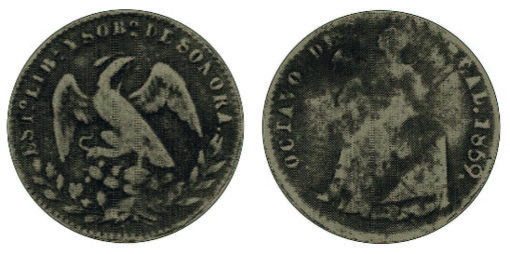
KM 337 Octavo of Sonora 1859
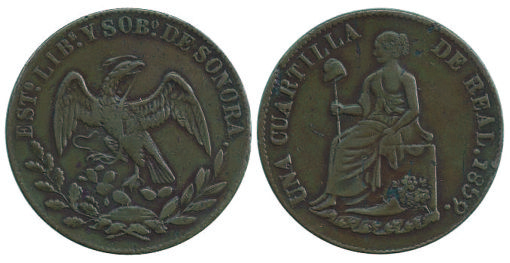 <
<
KM 365 Cuartilla of Sonora 1859
The new cuartilla and octavo of Sonora share the same design: on one side, the national arms of the decree of 14 April 1823: a Mexican eagle looking to the right, with a serpent grabbed with its beak and right talons, with open wings and standing on its left foot on a nopal cactus of eleven segments that protrudes from a rock on a lake; at the bottom, one branch of olive (or laurel) to the right and one of Encino oak to the left, tied up with a ribbon; and above the eagle — in semicircle around the margins, the legend — “EST.O LIB.E Y SOB.O DE SONORA.” — Spanish abbreviations for THE FREE & SOVEREIGN STATE OF SONORA. On the other side there is this classical allegorical representation of Liberty, as a feminine figure with braided hair, left breast exposed, seating on a pedestal, facing left and holding a pole with her right hand and a Phrygian hat at the end of it; her left hand is resting and the pedestal stand on a blanket of flowers with a Cornucopia in front, facing right. Around the lady — in semicircle — from left to right the legend indicating the value — either “UNA CUARTILLA DE REAL” or “OCTAVO DE REAL” — followed by the issuing date flanked by dots. The seating Lady Liberty — a prevalent iconography in Mexican state coinage since at least 1828 — was introduced for its first time to Sonora in 1859 and on this matter it is difficult to ignore the artistic influence of contemporary American coinage:
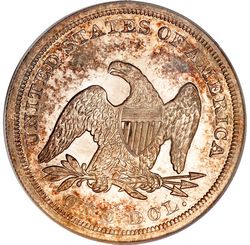
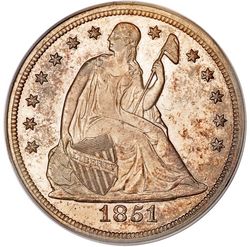
KM 71 1851 Seated Liberty Silver Dollar (Heritage Auction #1124, 2009. lot 2576)
Perhaps what makes Pesqueira’s new copper so especial to our story is that it carries an European-like very distinctive Eagle design, known today as the “Sonora Eagle” despite the fact that it was not conceived in Sonora, neither inaugurated by Sonora nor exclusively used by Sonora. As far as I can tell, based on publicly known specimens, this eagle design was officially used for the first time in a gold ½ escudo 1851 struck by the mint of Guadalupe y Calvo in Chihuahua state (then, a subsidiary of the Culiacán mintPradeau, op. cit.; Mike Dunigan and J.B. Parker, Resplandores. Cap and Rays 8 Reales of the Republic of México 1823-1897, Superior Stamp & Coin. Beverly Hills. 1997).
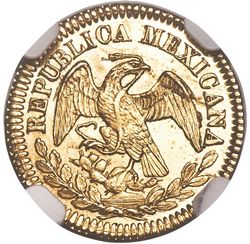
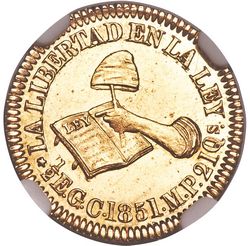
KM 378.3 ½E 1851 GC MP (Heritage Auctions, 6 September2019, lot 31977)
In Sonora silver this special eagle design was used for the first time on the 2 and 8 Reales dating 1861; interestingly, always paired to a particularly large Liberty Hat design that, in consequence, has been also termed the “Sonora Hat” (or “Sonora Cap”). Dunigan & Parker refer to these two coins as: “…perhaps the most beautiful of the Cap and Eagle 8 Reales series. These coins feature the high relief Sonora Cap and Eagle. It was necessary to strike these coins under great pressure to bring up the details on the central devices“ Dunigan and Parker, ibid.. I am from Sonora and I have to agree on this.

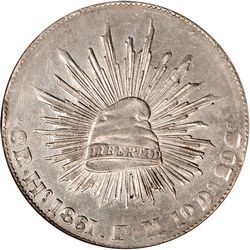
KM-377.9 8r 1861 Ho FM (Stack's Bowers Baltimore auction, 4 November 2010, lot 6348)
Wide "H", second "1" in date made with an "I" punch
In contrast, the earliest known appearance of this singular Eagle Hat pair occurred in Culiacán, in a copper pattern 8 Reales dated 1851Dunigan and Parker, ibid.. Consequently, this “Large Liberty Hat” design is also not originally from Sonora.
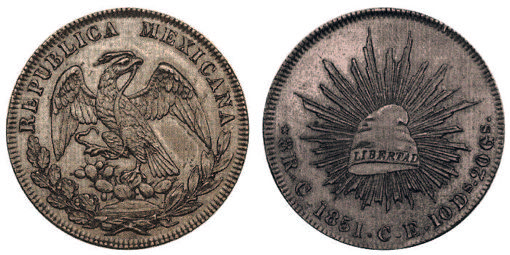 Culiacán copper pattern 8r 1851 C CE (Re-colored Dunigan and Parker, ibid.)
Culiacán copper pattern 8r 1851 C CE (Re-colored Dunigan and Parker, ibid.)
The Large Hat design is known to have been used in various denominations of Culiacán Reales dating 1853, 1854 (paired with “Sonora Eagle”) and 1857/4 (paired with “Sonora Eagle”). It seems the Eagle design was last used in Culiacán silver coinage in 1857 (1857/4) — apparently recycling some old 1854 dies — but it continued in use on Culiacán gold coins of small denomination (½, 1 and 2 Escudos), at least until 1870. About the Culiacán Eagle design, Dunigan and Parker wrote: “Most of 1854 saw the continuation of the Sonora Cap and the introduction of the magnificent Sonora Eagle to silver coinage. This eagle made its only appearances on an 8 Reales of Culiacán Mint this year. It appears in Hermosillo in 1861 and 1862. Both obverse and reverse of the Sonora Cap and Eagle dies were produced from the same hub responsible for the 8 Reales pattern C 1851 CE. It is interesting to appreciate on why this reverse was not used on the 1853 issue. The Die Style of the 1854-1857 makes its first appearance this year. This Die Style is in much lower relief and seldom struck very well. Possibly the reason for discontinuing this beautiful design was that the minting equipment at Culiacán was not adequate to strike its high relief design. This is evident by the fact that well struck specimens of this issue are virtually non-existent. Many examples have extensive and severe die damage and deterioration” Dunigan and Parker, ibid..
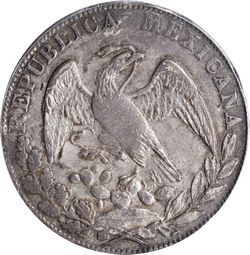
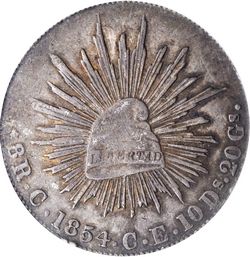
KM 377.3 8r 1854 C CE (Stack’s Bowers auction, 24 June 2021, lot 72285)
Out of the 14 active mints of the nineteenth century Mexican Republic, only four mints are known to have used the Eagle design of the new 1859 Sonora cuartillas: Guadalupe y Calvo (GC) in Chihuahua (in 1851), Culiacán (C) in Sinaloa (in its 1851 pattern & since 1854) — both under control of the Jecker-Torre & Co. — Hermosillo (Ho) since 1861 and Alamos (As) in 1872, both in Sonora under the same Douglas-Symon-Miller administration. The Large Hat design seems to have been used only at Culiacán (since 1853), Hermosillo (since 1861) and Alamos (in 1872).
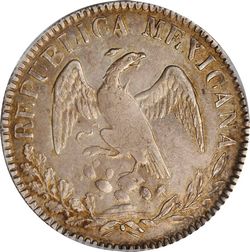

KM 374 2r 1872 A AM (Stack’s Bowers auction, 23 October 2019, lot 72547)
The migration of these punches, dies and/or hubs from Chihuahua/Culiacán to Hermosillo at one point before 1861 suggests a tight historical relationship between these mints — or at least between an artist engraver working for the private foreign entities that managed them. According to official accounts, the powerful firm Manning & Mackintosh owned the Guadalupe y Calvo Mining Company that was leasing the mints of Culiacán (C) and Guadalupe y Calvo (GC). In 1849, Mackintosh & Co. sold both mints to the firm Jecker, Torre & Co Pradeau, op. cit. . The new leaseholders ran the Guadalupe y Calvo mint until 22 May 1852Dunigan and Parker, op. cit., when it was closed forever.
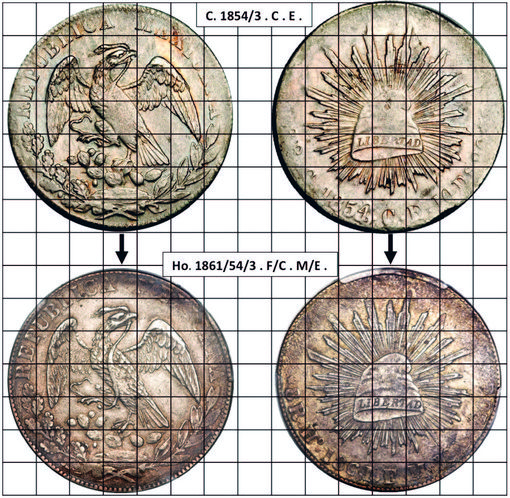
Die-association exercise between 1854/3 C CE (Stack’s Bowers & Ponterio auction, 2011) and 1861/54/3 Ho F/
C.M/E (listed as 1861/51) (Heritage NYINC Auction #3037, 4 January 2015, lot 30332)
Considering this, I regret to say that calling these designs “Sonora Hat” & “Sonora Eagle” — despite it sounding awesome to me — is, at minimum, misleading and perhaps it would be more appropriate to call them the “Guadalupe Eagle” (in reference to “Guadalupe y Calvo” 1851), the “Jecker Hat & Eagle” (in reference to the company that ran both the mint of Culiacán and Guadalupe y Calvo in 1851) or maybe just simply the “Culiacán Hat & Eagle” (in reference to the 8 Reales pattern of 1851 and to all the other coins issue there before any mint in Sonora was even running).
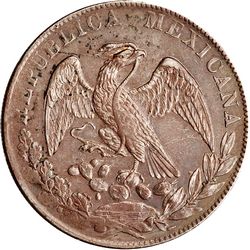
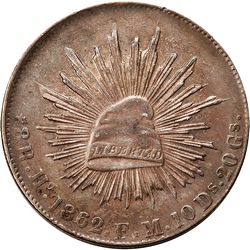
KM 377.9 8r 1862 Ho FM (Stack's Bowers Baltimore auction, 6 November 2010, lot 6350)
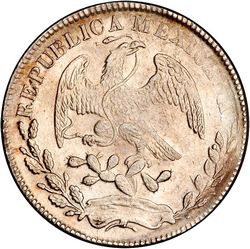
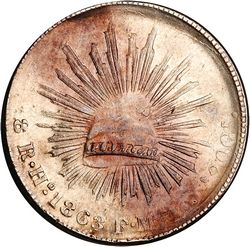
KM 377.9 8r 1862 Ho FM (Stack's Bowers Baltimore auction, 6 November 2010, lot 6353)
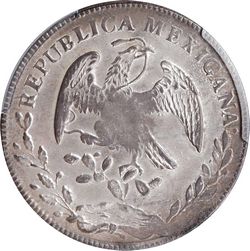
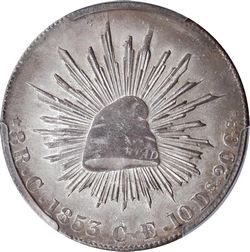
KM 377.3 8r 1853 C CE (Stack’s Bowers auction, 24 June 2021, lot 72283)
"MEXIGANA" legend error.
,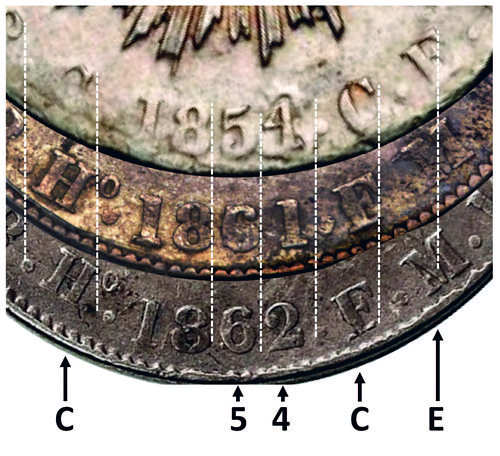
Alignment comparison between 8 reales of Culiacán 1854/3 C CE (Stack’s Bowers Baltimore Auction, May 2011, lot 8515), Hermosillo 1861 Ho FM (Heritage Auction #61167, 2010, lot 98102) and 1862 Ho FM (Stack's Bowers Baltimore auction, 6 November 2010, lot 6353).
Certain elements of the Culiacán die (such as the C, 5, 4, C and E) can still be seen on Hermosillo dies.
